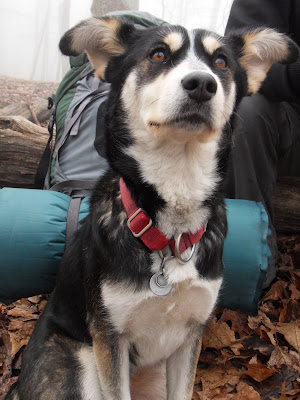
 Thou saw the fields laid bare an' waste, An' weary winter comin fast, An' cozie here, beneath the blast, Thou thought to dwell, Till crash! the cruel coulter past Out thro' thy cell.
Thou saw the fields laid bare an' waste, An' weary winter comin fast, An' cozie here, beneath the blast, Thou thought to dwell, Till crash! the cruel coulter past Out thro' thy cell. -From “To a Mouse” by Robert Burns
It was the coldest night of the year. The van rocked as cold, howling gusts battered its starboard side. Despite the two pairs of wool socks I was wearing and the thermals I feverishly hurried into, I was still shivering inside my sleeping bag.
This was three months ago. I was in a YMCA camp in Greenville, NC, enrolled in a nine-day Wilderness First Responder course. There was a male barracks that I had the option of sleeping in, but I favored a solitary slumber away from the snores and smells of fellow students.
Leaves rustled and branches snapped. Beneath the din of the elements, I heard something else: a tinkling of silverware; a crinkling of plastic bags. These sounds were coming from the inside of the van, not the outside. I understood what this meant.
I have mice in my van. I turned my headlamp on and sketched figure-eights onto the floor like one of those prison spotlights shone onto brick walls in search of escaped detainees.
While I never saw a mouse, I noticed little black pellets—a third the size of a tic-tac—scattered everywhere: across my floor, atop my storage container, and—in more concentrated quantities—inside my waste basket and unwashed pots.
I should have noticed the pellets the previous day, but I likely dismissed them as remnants of other foods I’d eaten, unworried about the tiny meteor showers of rye bread and cracker crumbs that sprinkled from lips to floor.
Exhausted, I determined to forget about my intruders. I thought: Hell, I'm no foreigner to squalor and I've had my share of face-to-face encounters with much larger and far more intimidating mammals. So why should I let a few harmless rodents ruin my night?
My imagination, however—when confronted with the ridiculous—tends to take a turn for the wildly absurd.
I imagined how one of the bolder members of the colony would slink into my sleeping bag and tour my body like an explorer charting an exotic peninsula. Perhaps I’d come back the next day to see that—upon making use of my food—they’d multiplied tenfold. Swarms, several layers thick, would be writhing libidinously. There’d be unrestrained fornication, mothers would be eating their babies, and several of the more acrobatically-inclined would twirl on coat hooks and scamper up my hanging partition.
With each new sound—inside and out—I’d snap my headlamp on hoping to catch them red-handed. But each time, they’d slip into the many cavernous corners of my lair.
After an hour, I had had enough. I removed my pots and pans from the van for cleaning and threw out all my unpackaged food.
I tried one last time to fall asleep. And that’s when it hit me. I had cereal the previous morning. Were those cracker seeds at the bottom of my cereal bowl or were they… Oh no.
I think I ate mouse shit. The next day I cleaned the van like I’d never cleaned it before. I threw out bags of beans, rice, and boxes of cereal. I bought several mouse traps and slathered them in peanut butter. But none of the mice were caught. Without food, they likely emigrated to other vehicles.
I never took pictures of the episode. I figured this would be the one story I’d keep to myself. Something I’d tell nobody. It was embarrassing and shameful. Plus, my article had just published and I had gotten flak from people criticizing vandwelling for its squalid nature. The last thing I wanted was to write an entry about sharing such tight quarters with animals responsible for the plague.
But because I’ve determined that my shame is less important than an honest portrayal of vandwelling, I'm compelled to now tell the mouse story. Also, I, uh...
...have another mouse.
It came in at night. Though it left no evidence of eating my food, there was no question that there was a mouse in my van. I could hear it scurrying in my walls and ceiling. It was past midnight. Since it was too late to do anything about it, I laid there listening, nervously oscillating my eyes towards each rustle, click, chip and scrape.
In the morning, as I laid in my sleeping bag—with all possible entry points tightly sealed—I could see the impression of its feet in my ceiling upholstery. It was everywhere. Running back and forth, front and back, side to side. What the hell was it doing? Its assiduousness terrified me. What grand schemes did it have in mind?
I cleaned out the van again and bought more mousetraps. But it was never interested in my food, it seemed. Just my ceiling.
I thought about thwacking it with my boot, but then I’d have a dead mouse in my ceiling and neither the time nor the ambition to remove the carcass.


Perhaps I should just let it live, I thought. Maybe I ought to grant it this temporary respite from the unforgiving natural world. Or I could just look upon it as a pet. Soon it and its friends would convene in the van. I’d lecture my congregants about the fine art of a street hockey slapshot, the films of Stanley Kubrick, and the virtues of squalor. I’d become the “mouse man” at Duke. I’d walk around campus with my friends nestled in my underwear and coat pockets. I’d command them to attack my foes, and they’d protect the van from intruders, dropping like poop from the cracks of the ceiling onto unsuspecting masked heads.
These fantasies were scuttled after several more sleep-deprived nights. At one point, in a fit of anger, I stomped my boot against the ceiling—from end-to-end—in hopes of tormenting the poor bastard (or bastards). Then I got out my frying pan and did the same.
This time it was beneath me. I saw a dart of fur; brown lightning shoot up from the ground into the ceiling. I had him cornered. The ceiling upholstery fluttered desperately. I whacked away with my frying pan until it stopped.
It’s been a couple days and I haven’t heard another noise. Did it escape? Is it dead? Have I committed murder? Was the little guy just looking for an escape from the “blast” of “weary winter”?
These questions bothered me at first. But now I doze easily at night, unperturbed with what might still be above.










































